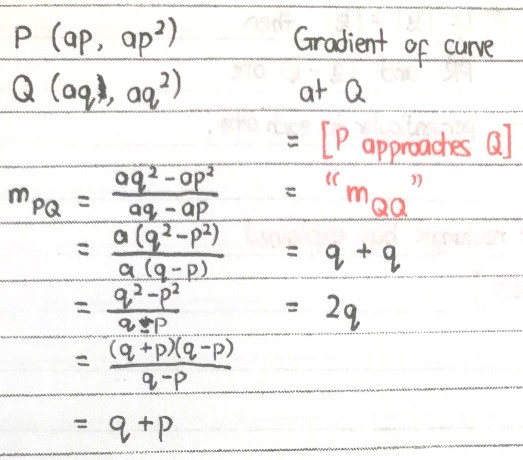Ask Singapore Homework?
Upload a photo of a Singapore homework and someone will email you the solution for free.

Question
junior college 1 | H2 Maths
One Answer Below
Anyone can contribute an answer, even non-tutors.

Need help for this question, thanks in advance!
= (y,p - y,q)/(x,p - x,q)
= (ap² - aq²)/(ap - aq)
= a(p + q)(p - q)/(a(p-q))
= p + q
Gradient of line from a chosen point on the curve to any other point on the curve
= (f(c+Δx) − f(c))/Δx
Where the chosen point's x coordinate is c (i.e x = c)
= (f(d) - f(c))/(d - c) , where d = c + ∆x and d is the x coordinate of any other point on the curve
Gradient of PQ
= ( f(aq+(ap-aq)) − f(aq) )/(ap - aq)
= (f(ap) - f(aq))/(ap - aq)
= (ap² - aq²)/(ap-aq)
= p + q
(This is essentially what was found earlier. using point Q, x = aq in this case and your ∆x = ap - aq)
Recalling what you've learned from limits,
Gradient of curve
= limit of (f(c+Δx) − f(c))/Δx when ∆x → 0.
For f(x) when x = c.
(Also known as your dy/dx)
P and Q can be any 2 different points in the circle. They are arbitrary. So we can let Q be our chosen point and P be the other point.
So as your ∆x →0, ap→aq.
I.e the second point is getting closer to and tending towards Q.
Then p → q
So your gradient p + q → 2q
Therefore it's just 2q.
So gradient at Q
= Gradient of chord PQ as P —> Q
= “Gradient of QQ” (the ultimate tangent is achieved when P actually reaches Q; just before this, the chord PQ is very close to how a tangent at Q looks like)
= q + q
= 2q
This is how the tangent to a curve is defined to be; the limit when the random point P approaches point Q.
Unlike conventional mathematics where we cannot allow denominators to become zero at any point in the workings, the limits allow this idea.
For further reading :
https://brilliant.org/wiki/tangent-line-point/
To convince yourself that it's 2q
y = at²
x = at
so x² = a²t² = a(at²)
y = at² = a²t²/a = x²/a
dy/dx = 2x/a
Sub x = aq,
dy/dx = 2aq/a = 2q
See 1 Answer





